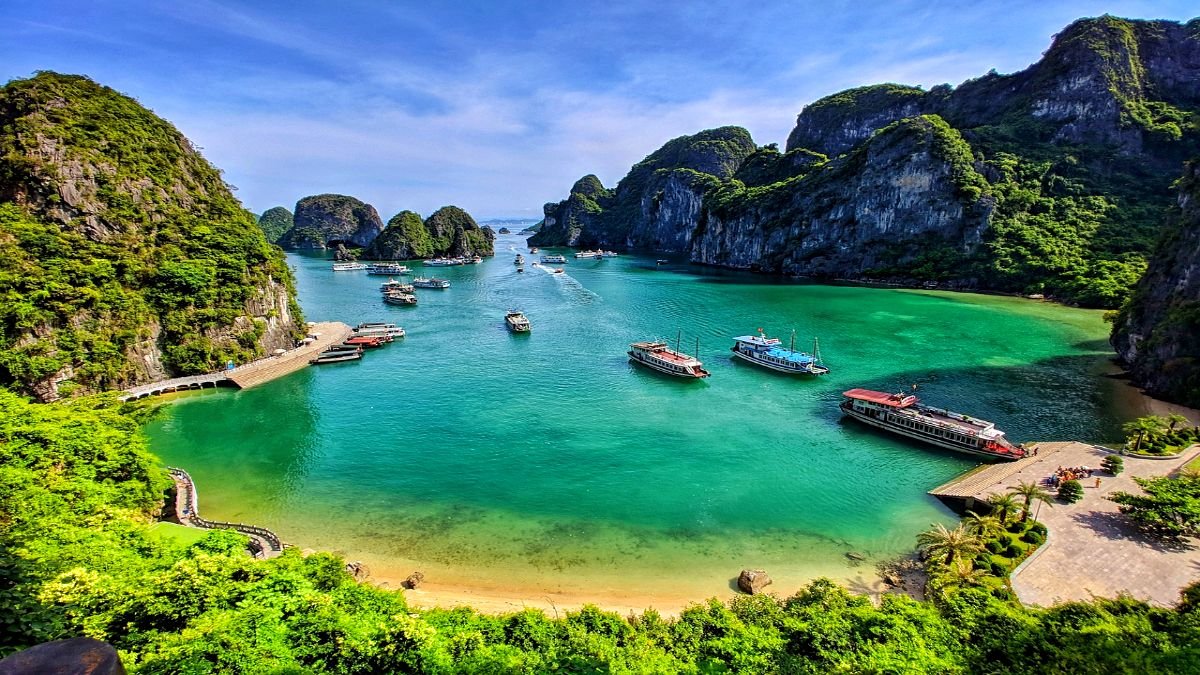Overview:
Vietnam is a mesmerizing destination with its blend of natural beauty, historical richness, and vibrant culture.
From the stunning limestone karsts of Ha Long Bay to the bustling streets of Ho Chi Minh City, Vietnam offers a diverse array of experiences for travelers.
The country’s history, shaped by its ancient dynasties, French colonial rule, and the Vietnam War, adds depth and intrigue to its tourist attractions.
In this blog, we will explore the 15 best places to visit in Vietnam, highlighting their historical and cultural significance, unique features, and essential travel tips.
Table of Contents
1. Ha Long Bay
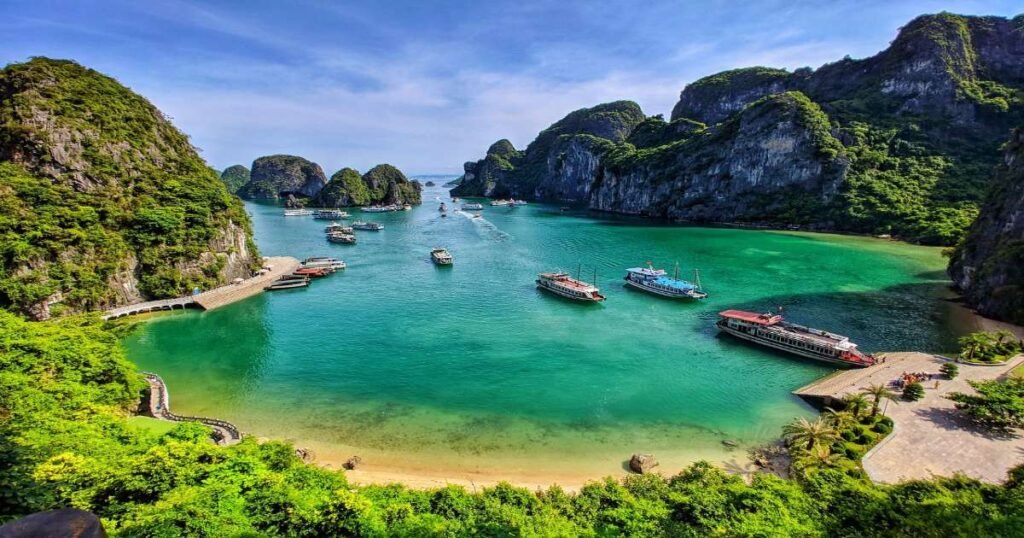
Located in northeastern Vietnam, Ha Long Bay is a UNESCO World Heritage Site famous for its emerald waters and thousands of towering limestone islands topped with rainforests.
Historical and Cultural Significance: Ha Long Bay has been an inspiration for poets and artists throughout Vietnam’s history. The bay’s name translates to “Descending Dragon,” a reference to local legends about dragons creating the islands by spitting jewels and jade into the sea.
Unique Features: The bay is home to thousands of limestone karsts and islets, some of which feature caves with stunning stalactites and stalagmites.
Best Time to Visit: The best time to visit Ha Long Bay is from October to April when the weather is cool and dry.
Travel Tips:
- Transportation: Ha Long Bay is a 4-hour drive from Hanoi, with many tour operators offering transportation.
- Accommodation: Stay on a traditional junk boat for a unique overnight experience or opt for beachfront hotels on nearby islands.
- Local Customs: When visiting caves or temples within the bay, dress modestly and respect the sacred spaces.
2. Hanoi Old Quarter
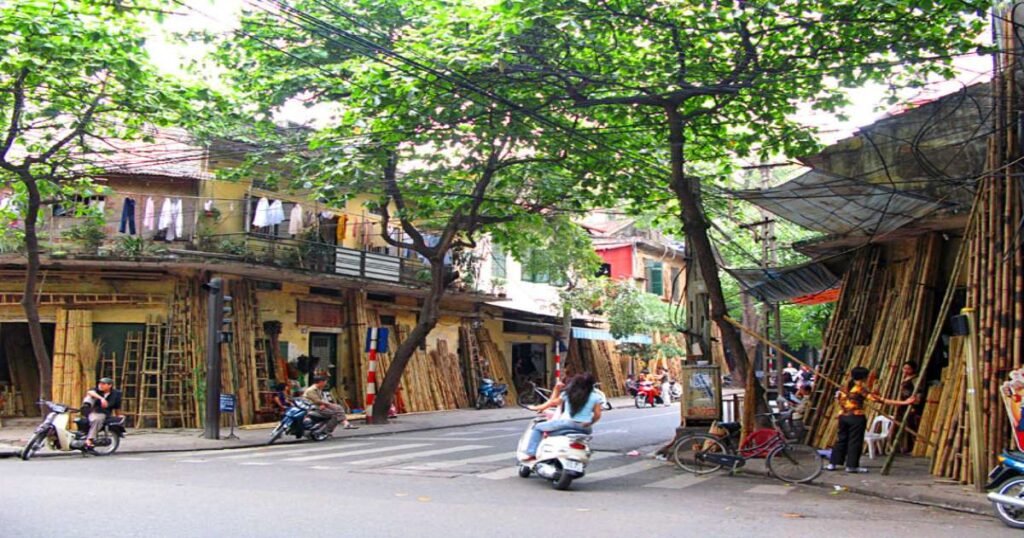
Hanoi’s Old Quarter is the historical heart of Vietnam’s capital city, where narrow streets buzz with life. It’s a hub of traditional shops, markets, and food stalls, providing a glimpse into Vietnamese urban life.
Historical and Cultural Significance: The Old Quarter dates back to the 13th century and has been a vital commercial and cultural center.
Unique Features: The Old Quarter is famous for its “tube houses,” narrow homes designed to minimize taxes based on street frontage.
Best Time to Visit: The best time to visit is during spring (March to April) and autumn (September to November) when the weather is cool and pleasant.
Travel Tips:
- Transportation: The Old Quarter is walkable, but you can also use cyclos (bicycle taxis) for short rides.
- Accommodation: There are plenty of boutique hotels and guesthouses in the Old Quarter, offering easy access to major attractions.
- Local Customs: Bargaining is common in markets, but do so politely. Try the street food, but ensure it’s from a clean and reputable vendor.
3. Cu Chi Tunnels
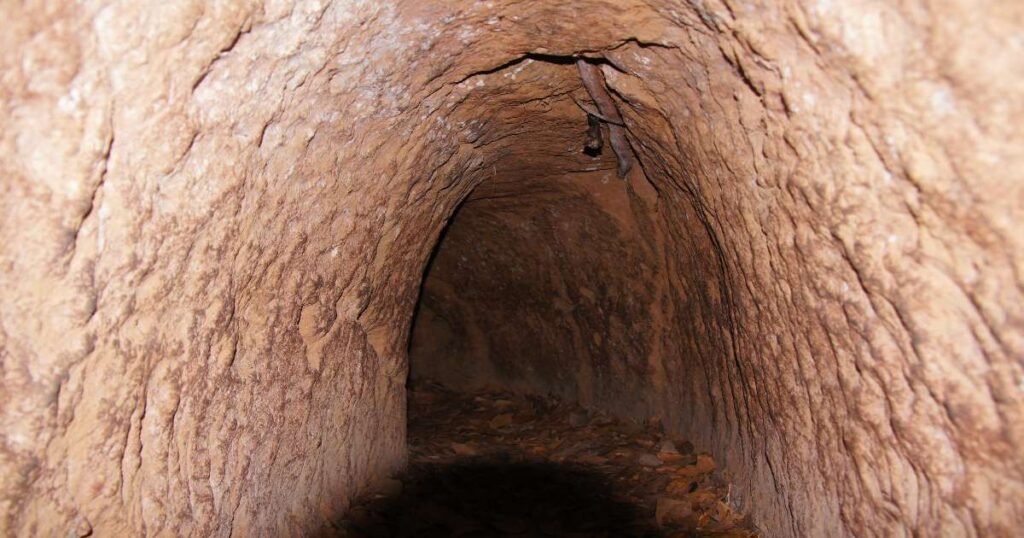
The Cu Chi Tunnels, located near Ho Chi Minh City, are a network of underground tunnels used by the Viet Cong during the Vietnam War.
Historical and Cultural Significance: These tunnels played a significant role during the Vietnam War, serving as hiding spots, supply routes, and living quarters for Vietnamese soldiers.
Unique Features: Visitors can crawl through sections of the tunnels to get a firsthand experience of life underground during the war. The site also features exhibitions of booby traps, weapons, and life-size replicas of war scenes.
Best Time to Visit: Visit between December and April, during the dry season, for the best experience.
Travel Tips:
- Transportation: The Cu Chi Tunnels are about a 1.5-hour drive from Ho Chi Minh City. Many tours include transportation.
- Accommodation: Ho Chi Minh City offers a wide range of accommodations, from budget hostels to luxury hotels.
- Local Customs: When visiting the tunnels, it’s important to be respectful of the historical significance and the memories of those who suffered during the war.
4. Hoi An Ancient Town
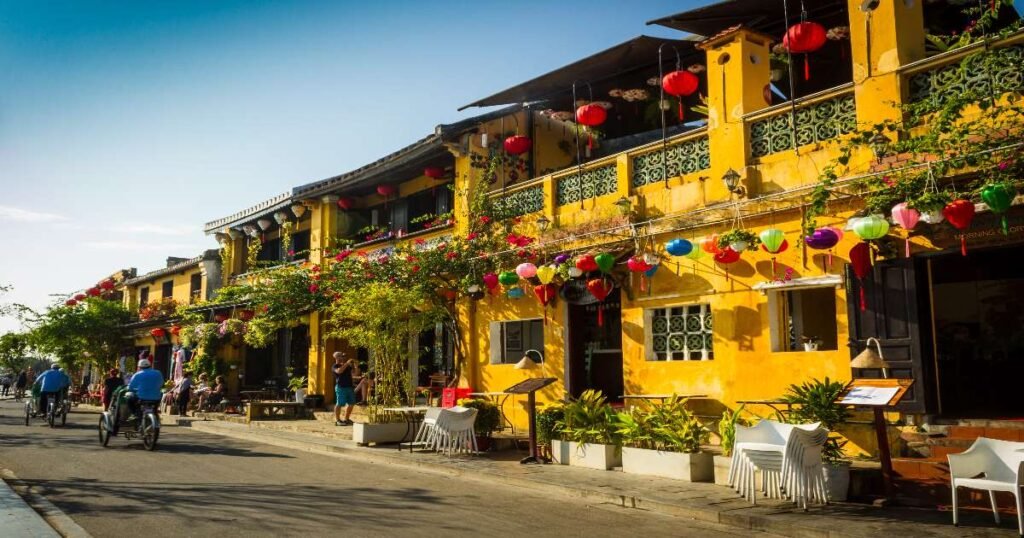
Hoi An is a beautifully preserved ancient town located on the central coast of Vietnam. Known for its charming streets lined with yellow buildings, lanterns, and canals.
Historical and Cultural Significance: Hoi An was a major trading port from the 15th to the 19th century, attracting merchants from China, Japan, and Europe.
Unique Features: The town is known for its lantern-lit streets, Japanese Covered Bridge, and vibrant night markets. Visitors can explore traditional wooden houses, pagodas, and temples.
Best Time to Visit: The best time to visit Hoi An is from February to April when the weather is warm but not too humid.
Travel Tips:
- Transportation: Hoi An is easily walkable, and bicycles are available for rent to explore the surrounding countryside.
- Accommodation: Stay in charming guesthouses or boutique hotels within the ancient town for an authentic experience.
- Local Customs: Participate in the lantern festival if you visit during a full moon, and respect the quiet atmosphere of temples and shrines.
5. Mekong Delta
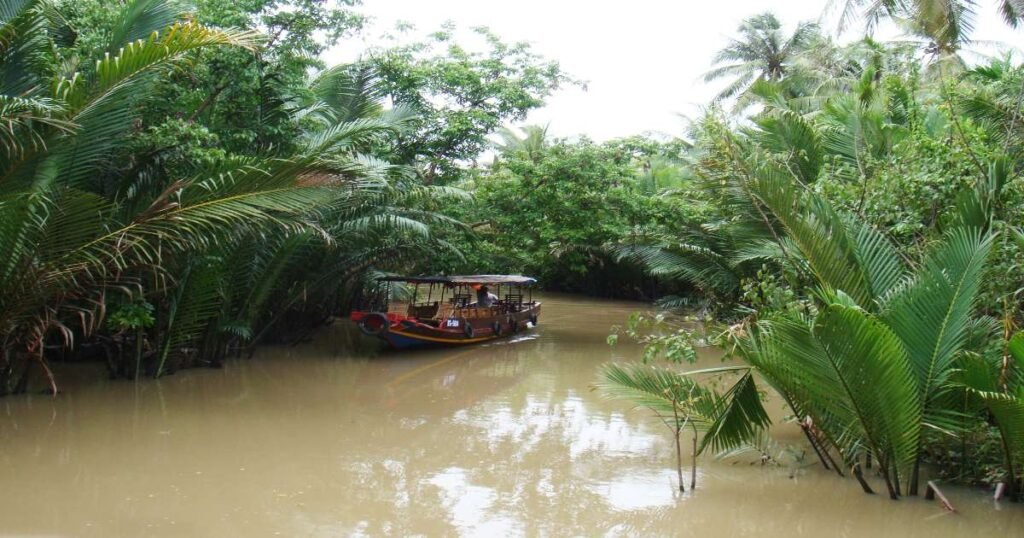
The Mekong Delta, located in southern Vietnam, is a vast network of rivers, swamps, and islands. Known as the “Rice Bowl” of Vietnam, this region is famous for its floating markets, lush landscapes, and vibrant local culture.
Historical and Cultural Significance: The Mekong Delta has been a hub of agriculture and trade for centuries. Its rich soil and waterways make it a vital region for rice production.
Unique Features: Visitors can take boat tours to explore the maze of waterways and visit local villages, fruit orchards, and farms.
Best Time to Visit: The best time to visit is during the dry season, from November to April when the water levels are stable for boat trips.
Travel Tips:
- Transportation: Boats are the primary mode of transportation in the delta. You can also take buses or hire private cars from Ho Chi Minh City to reach the area.
- Accommodation: Homestays in local villages offer a unique and immersive experience, or you can stay in hotels in nearby cities like Can Tho.
- Local Customs: Engage with the locals by participating in cooking classes or fruit tastings, and remember to support local artisans by purchasing handmade goods.
6. Phu Quoc Island
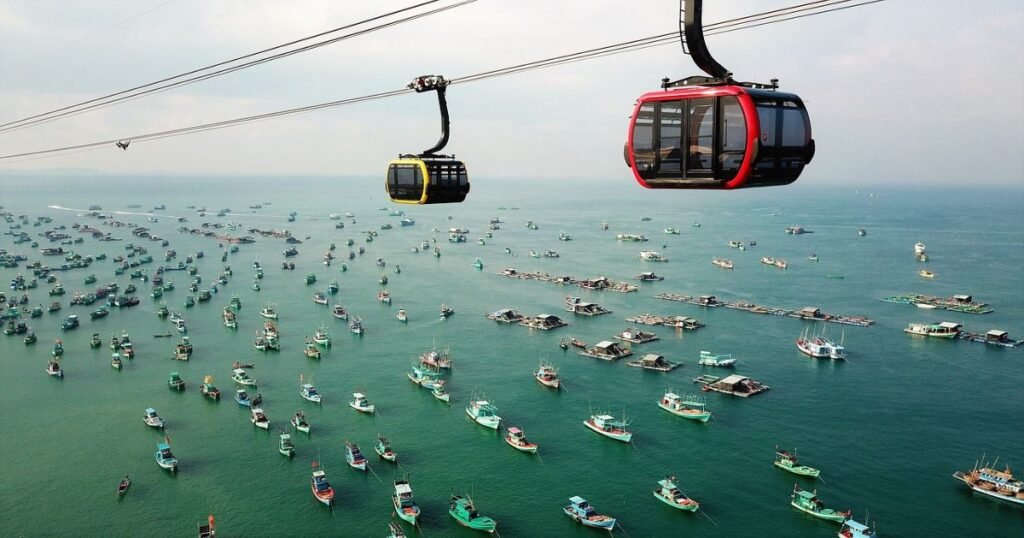
Phu Quoc is Vietnam’s largest island, located in the Gulf of Thailand. Known for its white-sand beaches, turquoise waters, and laid-back vibe, it’s a tropical paradise for beach lovers and adventurers alike.
Historical and Cultural Significance: Phu Quoc has a rich history, having been claimed by both Cambodia and Vietnam over the centuries.
Unique Features: The island is home to stunning beaches like Long Beach and Sao Beach, as well as the Phu Quoc National Park, which offers hiking and wildlife-watching opportunities.
Best Time to Visit: The best time to visit Phu Quoc is from November to March, during the dry season when the weather is ideal for beach activities.
Travel Tips:
- Transportation: Phu Quoc has an international airport, with direct flights from major cities like Hanoi and Ho Chi Minh City.
- Accommodation: The island offers a range of accommodations, from luxury resorts to budget guesthouses.
- Local Customs: When visiting Phu Quoc’s fishing villages, be respectful of the local culture, and try the island’s famous fish sauce, which is a local delicacy.
7. Sa Pa and the Terraced Rice Fields
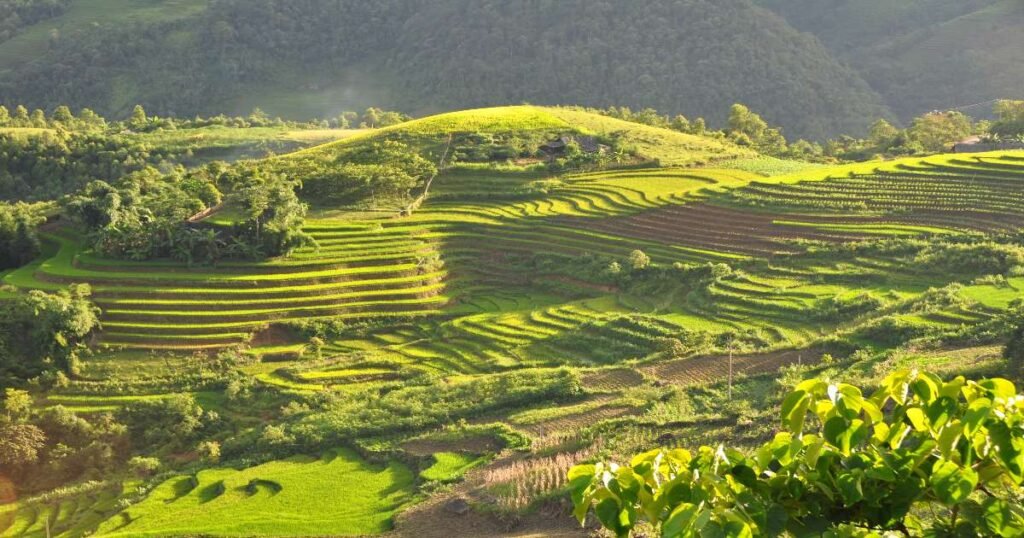
Sa Pa, located in the northwest of Vietnam near the Chinese border, is known for its stunning terraced rice fields and rugged mountain landscapes.
Historical and Cultural Significance: Sa Pa is home to several ethnic minority groups, including the Hmong, Dao, and Tay people, who have lived in the region for centuries.
Unique Features: The region is also home to Fansipan Mountain, the highest peak in Vietnam, often called the “Roof of Indochina.”
Best Time to Visit: September to November, during the harvest season when the rice terraces are golden and the weather is clear for trekking.
Travel Tips:
- Transportation: Sa Pa can be reached by train or bus from Hanoi, followed by a short car ride to the town.
- Accommodation: There are many guesthouses and homestays in and around Sa Pa, offering comfortable and affordable options.
- Local Customs: When visiting ethnic minority villages, be mindful of their customs and traditions. Photography is allowed, but it’s polite to ask permission first.
8. Phong Nha-Ke Bang National Park
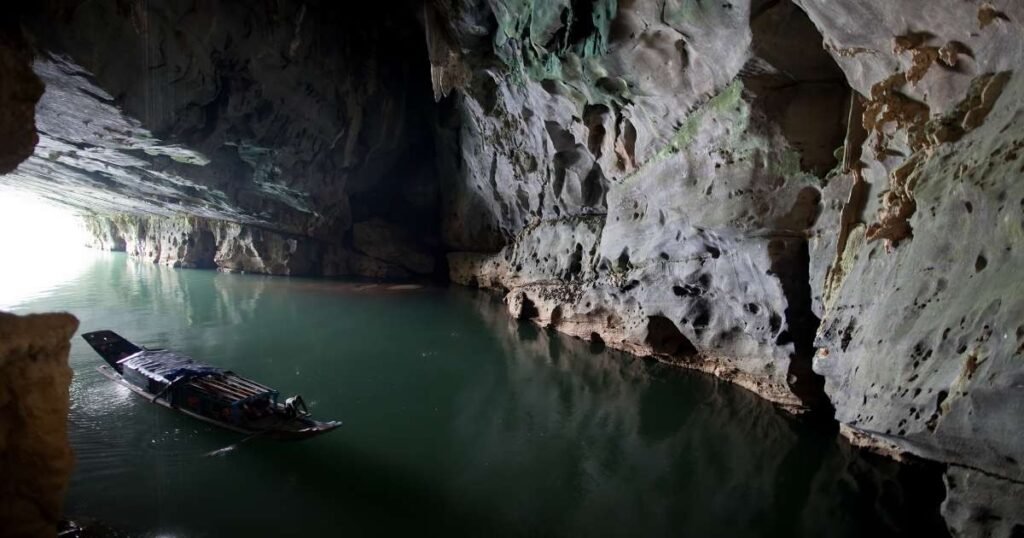
Phong Nha-Ke Bang National Park, a UNESCO World Heritage Site, is located in central Vietnam. It has extensive cave systems, including some of the largest caves in the world.
Historical and Cultural Significance: The park is home to one of the oldest karst mountains in Asia, formed over 400 million years ago.
Unique Features: The park boasts several famous caves, including Son Doong, the largest cave in the world, and Phong Nha Cave, known for its underground rivers and rock formations.
Best Time to Visit: February to August, when the weather is dry, and the caves are open to visitors.
Travel Tips:
- Transportation: Phong Nha-Ke Bang is accessible by bus or car from Dong Hoi City, which has an airport and train station.
- Accommodation: The nearby town of Phong Nha offers various hotels, hostels, and eco-lodges for travelers.
- Local Customs: Stick to marked trails in the park and respect wildlife. Local guides are knowledgeable and can offer deeper insights into the park’s history and geology.
9. Hue Imperial City
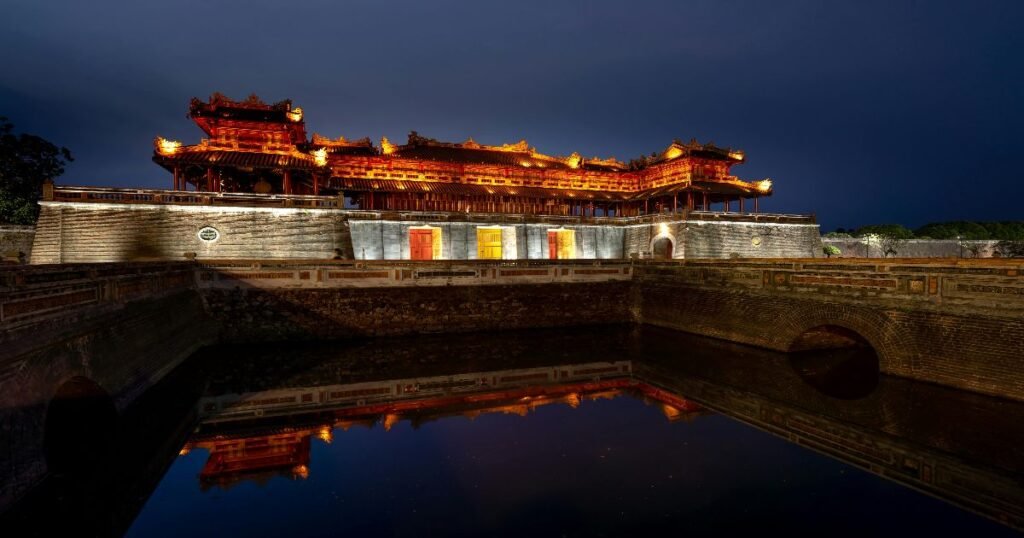
Hue, located in central Vietnam, was the imperial capital of the Nguyen Dynasty from 1802 to 1945. The city is famous for its well-preserved palaces, temples, and tombs.
Historical and Cultural Significance: Hue’s Imperial City is a UNESCO World Heritage Site and was once the political, cultural, and religious heart of Vietnam.
Unique Features: The Imperial City is surrounded by a moat and thick stone walls and contains numerous buildings, including the Forbidden Purple City, Thai Hoa Palace, and the Tombs of the Emperors.
Best Time to Visit: January to April when the weather is mild and the city is less crowded.
Travel Tips:
- Transportation: Hue is accessible by train, bus, or flight from major cities like Hanoi and Ho Chi Minh City.
- Accommodation: There are a variety of hotels and guesthouses in Hue, ranging from budget to luxury.
- Local Customs: When visiting temples and royal tombs, dress modestly and be respectful of the historical significance of these sites.
10. Mui Ne Sand Dunes
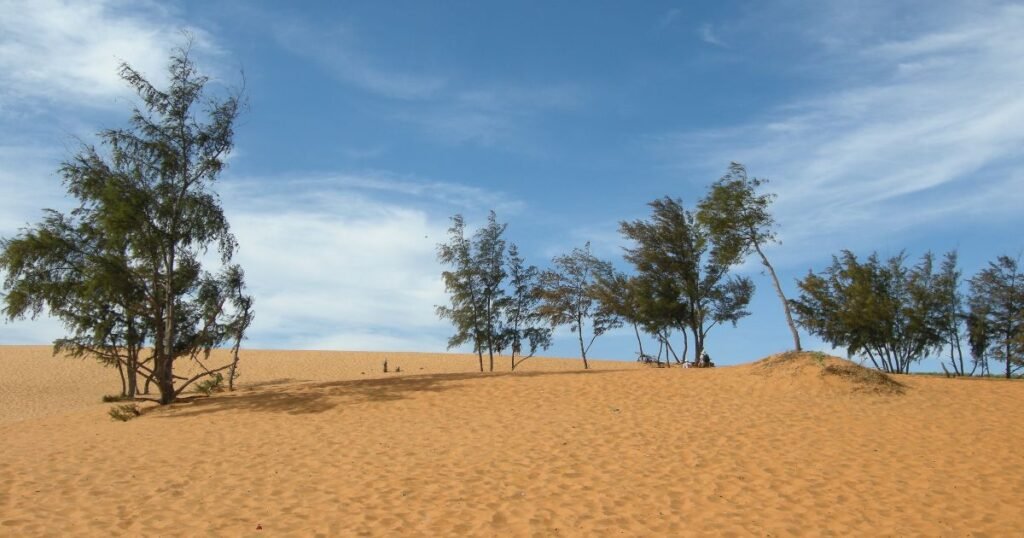
Mui Ne, a coastal town in southeastern Vietnam, is known for its stunning sand dunes, which offer a unique desert-like landscape in contrast to the country’s lush forests and beaches.
Historical and Cultural Significance: Though Mui Ne’s sand dunes are more of a natural wonder than a historical site, the region is home to the Cham people, who have lived in the area for centuries
Unique Features: The White Sand Dunes and Red Sand Dunes are the main attractions, with vast stretches of sand that seem to change colors depending on the time of day.
Best Time to Visit: November to March when the weather is dry and cool, making it ideal for outdoor activities.
Travel Tips:
- Transportation: Mui Ne is about a 4-hour drive from Ho Chi Minh City, and many buses and private cars offer transportation.
- Accommodation: Beachfront resorts and budget guesthouses are available in Mui Ne, offering stunning views of the coast.
- Local Customs: Be respectful of the local Cham culture and avoid littering on the dunes to preserve their beauty.
11. Ba Be National Park
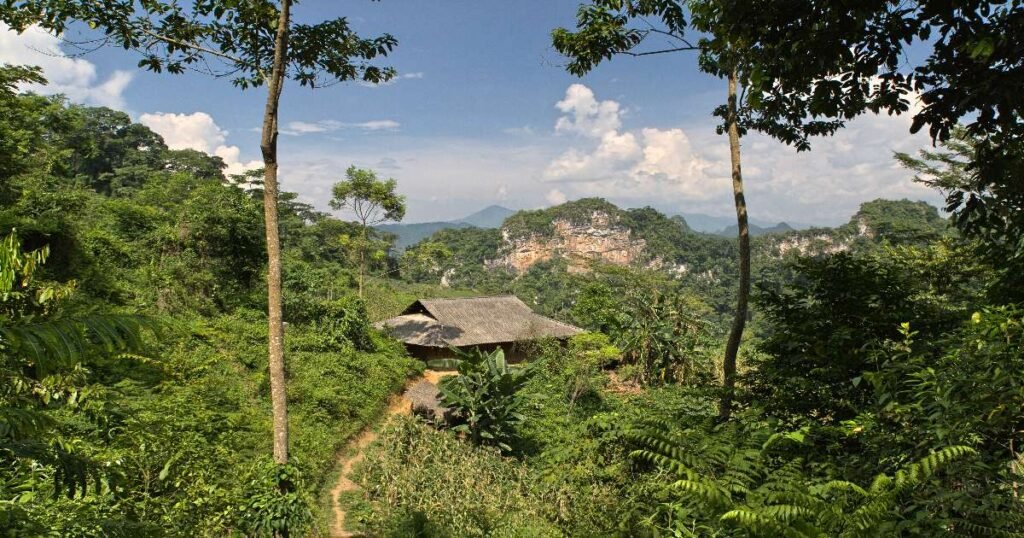
Located in northern Vietnam, Ba Be National Park is a hidden gem known for its pristine lakes, rivers, waterfalls, and lush forests, and offers a peaceful retreat from the bustling cities.
Historical and Cultural Significance: Ba Be is home to several ethnic minority groups, including the Tay people, who live in traditional stilt houses around the park.
Unique Features: The park’s main attraction is Ba Be Lake, the largest natural freshwater lake in Vietnam, which is surrounded by towering limestone mountains.
Best Time to Visit: October to April when the weather is dry and cool, making it perfect for outdoor exploration.
Travel Tips:
- Transportation: Ba Be is about a 5-hour drive from Hanoi, and private cars or buses can be arranged.
- Accommodation: Homestays in local villages offer a chance to experience the traditional lifestyle of the Tay people.
- Local Customs: When staying in homestays, respect local customs and traditions, and engage with the community by participating in cooking or farming activities.
12. Ninh Binh and Tam Coc
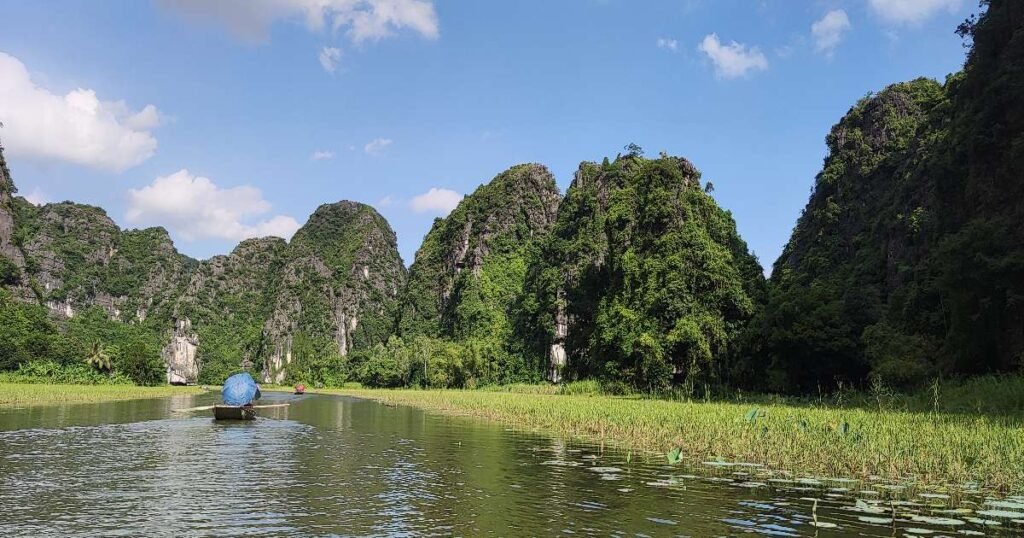
Often referred to as “Ha Long Bay on land,” Ninh Binh is a stunning destination with towering limestone cliffs, rice paddies, and winding rivers.
Historical and Cultural Significance: Ninh Binh was once the capital of Vietnam during the Dinh and Le dynasties in the 10th and 11th centuries.
Unique Features: The boat rides through the caves of Tam Coc are the highlight of any visit to Ninh Binh. The landscape is dotted with ancient temples and pagodas, offering a peaceful and spiritual atmosphere.
Best Time to Visit: May to September when the rice fields are lush and green.
Travel Tips:
- Transportation: Ninh Binh is a 2-hour drive from Hanoi, and buses and trains are available.
- Accommodation: Stay in eco-lodges or homestays for an authentic experience in the countryside.
- Local Customs: Respect the quiet and spiritual nature of the temples, and dress modestly when visiting religious sites.
13. Cao Dai Temple
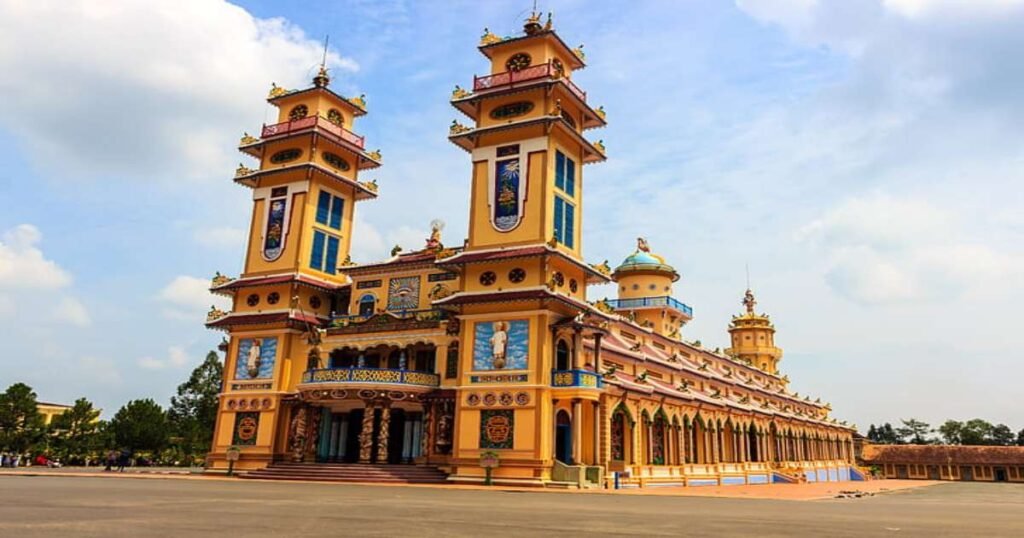
The Cao Dai Temple, located in Tay Ninh, about 100 kilometers from Ho Chi Minh City, is the center of the Cao Dai religion, a unique syncretic belief system founded in Vietnam in the 1920s.
Historical and Cultural Significance: Cao Dai is a religion that unifies teachings from Buddhism, Christianity, Taoism, and Confucianism. The religion was founded with the aim of promoting world peace and harmony.
Unique Features: The Cao Dai Temple is an explosion of colors and ornate design, with vibrant pinks, blues, and yellows adorning its exterior and interior.
Best Time to Visit: The temple is open year-round. Visitors are welcome to observe the ceremonies from the balconies.
Travel Tips:
- Transportation: Tay Ninh can be reached by bus from Ho Chi Minh City, and the ride takes about 2-3 hours.
- Accommodation: There are limited accommodation options in Tay Ninh, so many visitors choose to take a day trip from Ho Chi Minh City.
- Local Customs: Visitors must remove their shoes and remain quiet during services. Men and women sit on opposite sides of the temple during the ceremony.
14. Con Dao Islands
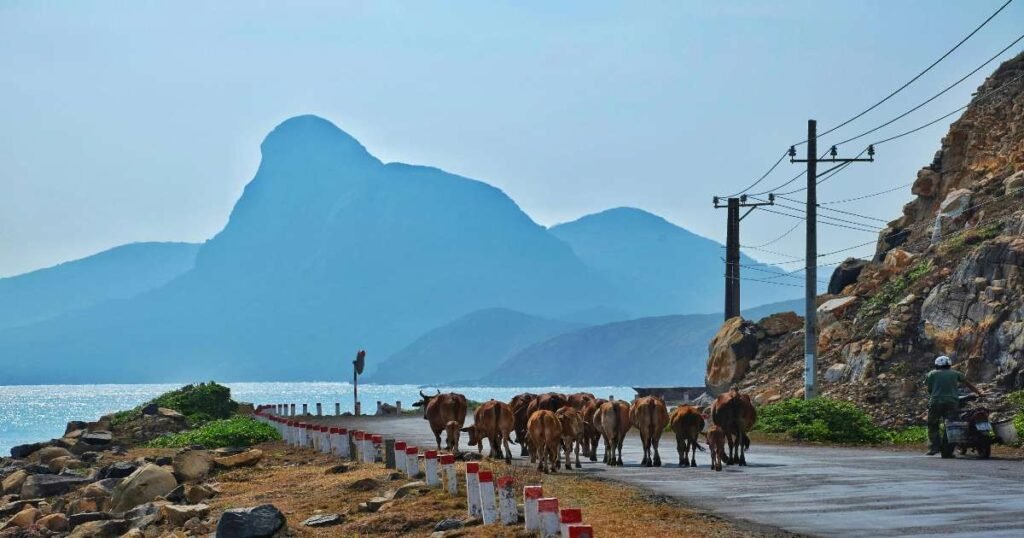
The Con Dao Islands, an archipelago off the southern coast of Vietnam, are known for their pristine beaches, lush jungles, and historical significance
Historical and Cultural Significance: Con Dao was once a notorious prison island, which was used to house political prisoners during both the French colonial period and the Vietnam War.
Unique Features: The islands are home to some of the most beautiful beaches in Vietnam, with crystal-clear waters, coral reefs, and abundant marine life.
Best Time to Visit: March to September, which is the turtle nesting season, providing a unique opportunity to witness this incredible natural event.
Travel Tips:
- Transportation: The islands can be reached by a short flight from Ho Chi Minh City or by boat from the mainland.
- Accommodation: There are a few resorts and eco-lodges on the islands, offering everything from budget to luxury options.
- Local Customs: Respect the protected areas, especially during turtle nesting season, and follow guidelines to avoid disturbing wildlife.
15. Ba Na Hills
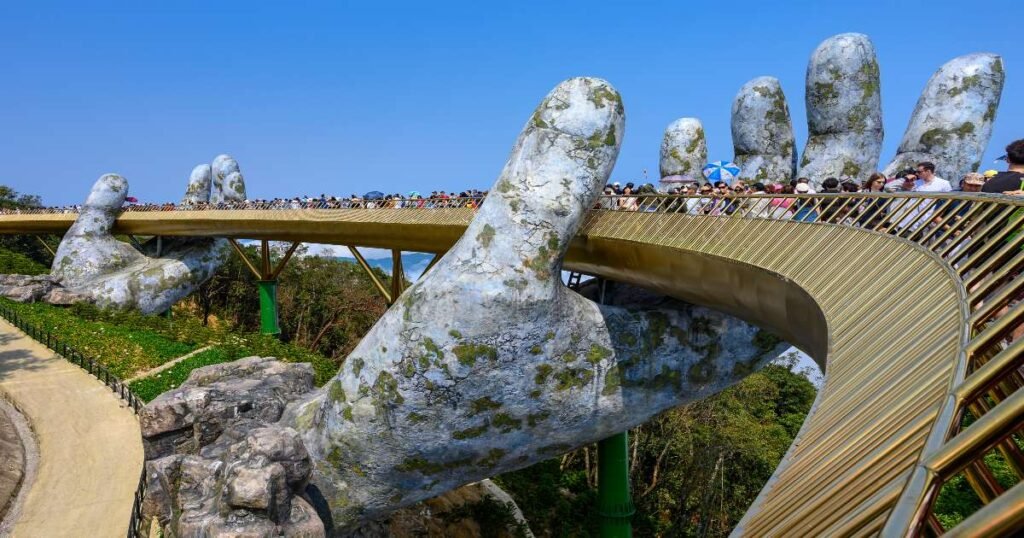
Ba Na Hills, located near Da Nang in central Vietnam, is a mountain resort complex that blends stunning natural beauty with man-made wonders. Famous for its cable car rides, the Golden Bridge, and the French Village.
Historical and Cultural Significance: Ba Na Hills was originally developed by French colonists in the early 20th century as a hill station to provide a cool retreat from the tropical heat.
Unique Features: One of the highlights of Ba Na Hills is the Golden Bridge, a pedestrian bridge supported by two giant stone hands that seem to emerge from the mountainside.
Best Time to Visit: April to August, when the weather is pleasant and clear, offering spectacular views of the surrounding countryside.
Travel Tips:
- Transportation: Ba Na Hills can be reached by a short car ride from Da Nang. The cable car station at the base takes you up the mountain.
- Accommodation: While Ba Na Hills is primarily a day trip destination, some visitors choose to stay in Da Nang, which offers a range of hotels and resorts.
- Local Customs: Ba Na Hills is a popular tourist spot, so expect crowds, especially on weekends and holidays. Arriving early in the day can help you avoid the biggest crowds.
Also Read: 15 Best Places to Visit in Japan
Conclusion:
Vietnam is a captivating destination rich in history, culture, and natural beauty. From the stunning landscapes of Ha Long Bay to the historical depth of Hue, each attraction offers a unique glimpse into the country’s vibrant heritage.
Whether you seek adventure, relaxation, or cultural immersion, Vietnam promises unforgettable experiences for every traveler.
Plan your journey to explore these top attractions and discover the magic of this remarkable nation.
FAQs
1. What is the best time to visit Vietnam?
The best time to visit Vietnam depends on the region you’re visiting. Generally, the months of March to April and September to November offer pleasant weather throughout the country. In the north, winters (November to February) can be chilly, while the south remains warm year-round.
2. Do I need a visa to visit Vietnam?
Most visitors need a visa to enter Vietnam. However, citizens of certain countries can enter visa-free for a limited period. It’s recommended to check the latest visa requirements before your trip.
3. What are some traditional Vietnamese foods I should try?
Some must-try Vietnamese dishes include pho (noodle soup), and veg banh mi (Vietnamese sandwich). Each region of Vietnam has its own specialties, so be sure to explore the local cuisine wherever you go.
4. Is Vietnam safe for tourists?
Vietnam is generally a safe country for tourists. However, like any destination, it’s essential to take basic precautions, such as avoiding poorly lit areas at night, securing your belongings, and being cautious of scams, particularly in tourist-heavy areas.
5. What is the best way to get around Vietnam?
Vietnam has an extensive transportation network, including trains, buses, and domestic flights. In cities like Hanoi and Ho Chi Minh City, taxis, motorbike taxis (known as “xe om”), and ride-hailing apps like Grab are popular options. For longer distances, domestic flights and trains are efficient.
6. Are there any cultural customs I should be aware of?
Yes, when visiting religious sites such as temples and pagodas, it’s important to dress modestly. Remove your shoes before entering, and avoid pointing your feet at religious statues. Additionally, showing respect to elders and learning a few basic Vietnamese phrases, such as “xin chào” (hello) and “cảm ơn” (thank you), is appreciated.
7. What currency is used in Vietnam?
The official currency of Vietnam is the Vietnamese dong (VND). Credit cards are widely accepted in larger cities, but it’s a good idea to carry cash, especially when visiting rural areas.
8. Can I use US dollars in Vietnam?
While some places, especially tourist areas, may accept US dollars, it’s best to use Vietnamese dong for most transactions. Currency exchange services are widely available in cities and at airports.

